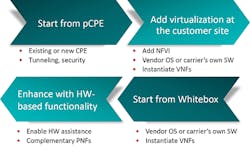The emerging virtual customer premises equipment (vCPE) approach for business customers enables some of the functionality associated with conventional CPEs and other customer-located appliances to be virtualized and optionally relocated to other network locations.
Most recently, a new understanding has evolved that broadens and widens its use cases and implementation options.
First, there is now a consensus that vCPEs are not just deployable over a single architecture model but rather a range of implementation options, with and without virtualization at the customer site. The question has now evolved to how virtualization can be deployed most efficiently at the customer site.
Second, the telecom industry now has a much greater understanding of the major vCPE use cases. These include IP VPNs, Ethernet services with virtualized capabilities, and, somewhat surprisingly, software-defined wide area network (SD-WAN) as a carrier service. For many, the last of these 3 scenarios was unexpected, since the SD-WAN was originally designed for the enterprise alternative.
Industry Forecasts
According to Doyle Research (http://doyleresearch.com/), "vCPE is one of the largest drivers of NFV deployment and will account for more than 20% of NFV-related services by 2018." This will be due in part to the fact that providers "are leveraging vCPE to rapidly deliver new services (e.g., SD-WAN and security) to allow customers to easily adjust their services mix."
Analysys Mason (www.analysysmason.com) observed that "enterprise vCPE-enabled services represent a significant opportunity . . . in the business network services market . . . through agile, on-demand service delivery and customer self-provisioning capabilities." The report also noted that vCPE gives providers a scalable, automated NFV and SDN-based solution to deploy both existing and new revenue-generating services rapidly. At the same time, they can keep their own operational costs down by replacing expensive, stranded physical network appliances with reusable, virtualized off-the-shelf servers, and reducing inefficient manual operations.
IHS Markit (https://ihsmarkit.com/) tracked spending on NFV hardware and software for delivery of software-based services to customers based on vCPE and enterprise vCPE use cases. Based on that data, they predicted that by 2020 the service provider NFV market will grow at a robust compound annual growth rate of 42% to $15.5 billion. Moreover, Michael Howard, senior research director for carrier networks, stated that "NFV software will comprise 80% of the $15.5 billion total in 2020 — or around $4 out of every $5 spent on NFV."
Deployment Options
There are 3 types of architecture that can be employed to introduce virtualization. (See Figure 1.)
Figure 1. Illustration of virtual CPE architecture deployment options.
Architecture Type A
With just a physical CPE (pCPE, without virtualization capabilities) at customer sites while all virtualization is located in the network/cloud.
Architecture Type B
With a universal CPE (uCPE, that enables hosting virtualized functions) at customer sites while virtualization is distributed between the network/cloud and customer sites.
Architecture Type C
With a universal CPE (uCPE) at customer sites while all virtualization sits at the customer sites.
What is critical to grasp from these different architectures is that vCPE deployment is not a cookie-cutter process. These 3 options serve different enterprise market segments, and can even co-exist within a single customer network.
Whatever the architecture may be, there are 2 scenarios, as illustrated in Figure 2, for launching vCPE deployment.
Figure 2. The 2 scenarios for implementing vCPE and expanding its functionalities.
Scenario 1
Start without virtualization at the customer site as the initial stage. This would be accomplished using a pCPE that provides tunneling and security. This option is tailored for the architecture type A (noted above). (This requires physical CPE at customer sites while all virtualization is located in the network/Cloud). Then virtualization can be added at the customer site using a standalone white box, or integrated with the pCPE (gray box).
Scenario 2
Start with colocation of separate white box server and existing CPEs at the customer site. As a next stage, collapse them into a single device to maximize performance and reduce costs. This scenario begins with a white box (basically a commercial, off-the-shelf system), which runs the vendor’s operating system or the carrier’s own software to host VNFs. Later on, the white box can be enhanced with hardware-based functionality, such as performance acceleration, switching or routing, Layer 2 or 3 demarcation and other physical network functions, in addition to VNFs. This option is tailored for architecture types B and C (noted above) as the starting point. (This requires universal CPE at the customer sites with virtualization either entirely at the customer sites or distributed between the network/Cloud and customer sites). Both these scenarios are equally valid. Technical and business drivers such as cost structure, targeted services, network architecture, use cases, and other parameters will determine where VNFs will be situated. Some applications (end-to-end encryption, WAN optimization, testing, and monitoring, for example) must be located at the customer premises by definition. Others are simply more effective at the customer premises. There are also operational and transport issues to consider, not to mention governmental regulations and policies related to data protection.
The vCPE, therefore, has been evolving and continues to do so. Standardization by industry bodies, beginning first of all with the Broadband Forum (www.broadband-forum.org/), is yet another contributing factor in considering the vCPE as a work in progress.
Today’s Reality
We are now at a point where vCPE is moving into its deployment stage. Not surprisingly, 2 alternative models reflecting 2 scenarios have been employed. The first — adopted, for example, by Orange and Deutsche Telekom AG in Europe — begins with a pCPE, while virtualization at the customer site will be added later. The second — adopted other carriers, such as AT&T — begins with virtualization using a white box server.
Operators outside North America and the European Union, which are the initial epicenters of vCPE developments, have a distinct advantage, since they will have the opportunity to carefully watch and assimilate the experience of their American and European counterparts before opting for one model over the other.
In this way, they will be able to leverage the research, expertise and interoperability testing accumulated during US and EU rollouts before charting their own path.
Conclusion
For service providers addressing the enterprise market, the vCPE sweet spot lies in its agile service offering, while introducing advanced software-defined provisioning and customer self-configuration, with ability to carry out shorter and more flexible deployment cycles for new services.
When implementing vCPE architecture, there are several options for VNF placement (in the data center, at the customer edge or a combination of both), each fitting a different scenario. As they plan vCPE deployments, service providers will need to consider how functionality placement affects bandwidth efficiency, security, survivability, performance, diagnostics, and, last but not least, service quality-of-experience for their enterprise customers.
Save
Save
Save







